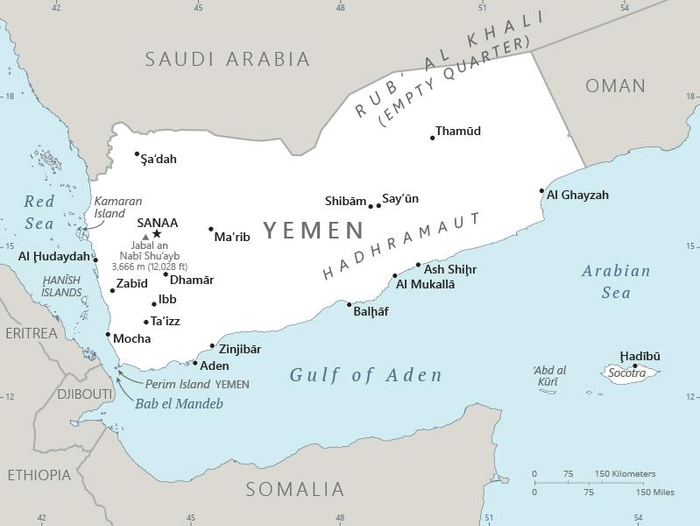
Yemen map showing major population centers as well as parts of neighboring countries and the Gulf of Aden and the Red Sea.
“The preparation of the naval force comes in light of the enemy mercenaries’ relinquishing of national sovereignty, and their exposing the country’s sovereign oil, gas and fishery resources to unprecedented plunder…”
While recent naval attacks by Yemen’s Ansarallah group—better known as the Houthis—have been justified as being in solidarity with Palestinians in Gaza, Ansarallah’s build-up of capabilities to engage in an anti-access naval campaign was motivated by domestic concerns that predate Israel’s operations against Hamas in Gaza. Beginning on 19 October, Ansarallah began targeting primarily commercial vessels in the Red Sea using unmanned aerial vehicles, ballistic missiles, and anti-ship cruise missiles. The majority of these weapons were shot down by ships from the USS Gerald Ford Carrier Strike Group.[i] These attacks were concurrent with other attacks carried out by Iranian allies, all presented as in solidarity with Palestinians in Gaza and as part of a coordinated anti-Israel response by members of the Iran-led “Axis of Resistance”—Hezbollah in Lebanon, “Islamic Resistance” militias in Iraq, and Ansarallah in Yemen. According to the accompanying excerpt from the official Yemeni daily 26 September, Ansarallah leaders have justified their buildup of anti-ship capabilities as motivated by their adversaries “exposing the country’s sovereign oil, gas and fishery resources to unprecedented plunder” and their attempts to “expand and control the most important strategic ports and islands, such as Socotra and Mayun [also known as Perim Island].” From Ansarallah’s perspective, its domestic adversaries—both the Saudi-backed Internationally Recognized Government and the Emirati-backed Southern Transitional Council—have used the early 2022 UN-brokered truce in Yemen to tighten control over resources and strategic locations on Yemen’s coastline with foreign assistance and complicity.[ii] In August 2023, a few months before hostilities broke out in Gaza, Ansarallah officials threatened to sink two oil tankers seeking to transport Yemeni oil for export from ports in the Gulf Aden under the control of Ansarallah’s domestic opponents. Ansarallah’s position vis-à-vis Red Sea shipping prior to 7 October, per the article, was “to encourage international navigation through the [Bab El Mandab] Strait provided that it does not harm the sovereignty, unity, security or independence of the Republic.” Thus, while Ansarallah’s attacks on shipping vessels transiting Bab El Mandab are—at least rhetorically—linked to Israel’s invasion of Gaza, they should also be understood as a deliberate effort by the group to assert control over the entirety of Yemen’s territorial waters and internationalize the struggle for control of Yemen’s resources and strategic locations.
Sources:
“قدرات اليمن في حماية البحار والمياه الوطنية Yemeni capabilities for protecting national seas and waterways,” 26 September (official Yemeni daily), 25 September 2023. https://www.26sep.net/index.php/local/64705-2023-09-25-05-09-57
”We were in a raging war with two ships coming to the port of Aden to plunder Yemeni gas, and they retreated four times, most recently yesterday. We informed the companies that owned the ships ‘Sinmar Jane’ and ‘Bolivar’ that we would strike them if they entered to loot gas from the port of Aden, and they are ready to do so. A few days earlier, President Al-Mashat vowed to ‘target the military bases of the Saudi-Emirati coalition forces on the Yemeni islands.’ At that time, he concurred with the Chief of Staff of the Naval Forces and Coastal Defense, Brigadier General Mansour Ahmed Al-Saadi, ‘on the level of qualitative armament that the naval forces now possess, which enables them to confront the enemy with all merit and ability, and allows them to meet the challenges…”
The Minister of Defense, Major General Muhammad Nasser Al-Atifi, had previously confirmed that maritime security of Yemeni territorial waters would be a priority in the next stage…
The preparation of the naval force comes in light of the enemy mercenaries’ relinquishing of national sovereignty, and their exposing the country’s sovereign oil, gas and fishery resources to unprecedented plunder. Alongside this organized plunder are the occupation’s efforts to expand and control the most important strategic ports and islands, such as Socotra and Mayun. It was necessary for the Yemeni armed forces to carry out their duty to protect the territorial waters and the sovereign wealth of oil, gas and fisheries from the dangers coming from the coalition of aggressors and their mercenaries from inside and outside the country, and to prepare themselves as a deterrent weapon for all these ambitions. Regarding freedom of international navigation in the Bab al-Mandab Strait, the position of the Republic of Yemen is specific and clear, which is to encourage international navigation through the Strait provided that it does not harm the sovereignty, unity, security or independence of the Republic.
Notes:
[i] For details on Ansarallah’s naval arsenal, see: “A Maritime Menace: The Houthi Navy,” Oryx Blog, 2 January 2023. https://www.oryxspioenkop.com/2023/01/a-maritime-menace-houthi-navy.html; “Houthis Showcase Large Arsenal Of Missiles, Drones At Sana’a Military Parade,” MEMRI, 21 September 2023. https://www.memri.org/tv/houthis-showcase-large-arsenal-missiles-drones-military-parade; “Under Fire in the Bab al-Mandab: Houthi Military Capabilities and U.S. Response Options,” The Washington Institute for Near East Policy, 8 December 2023. https://www.washingtoninstitute.org/policy-analysis/under-fire-bab-al-mandab-houthi-military-capabilities-and-us-response-options;“Houthi anti-ship missile systems: getting better all the time,” IISS, 4 January 2024. https://www.iiss.org/online-analysis/military-balance/2024/01/houthi-anti-ship-missile-systems-getting-better-all-the-time/ For details on Ansarallah’s anti-ship ballistic missiles, see: “We Might Have Just Seen the World’s First Anti-Ship Ballistic Missile Attack,” Popular Mechanics, 1 December 2023. https://www.popularmechanics.com/military/navy-ships/a45964460/first-anti-ship-ballistic-missile-attack-houthi-rebels/
[ii] For more on control over Socotra, see: Lucas Winter, “Regional Friction Over Yemen’s Socotra Island,” OE Watch, June 2018. https://community.apan.org/cfs-file/__key/telligent-evolution-components-attachments/13-17883-00-00-00-27-93-72/2018_2D00_06_2D00_01-Regional-Friction-Over-Yemen_1920_s-Socotra-Island-_2800_Winter_2900_.pdf?forcedownload=true; For more on control over Yemen’s Arabian Sea ports, see: Lucas Winter, “Saudis Seek Pathway to the Arabian Sea,” OE Watch, October 2018. https://community.apan.org/cfs-file/__key/telligent-evolution-components-attachments/13-17883-00-00-00-26-69-08/2018_2D00_10_2D00_01-Saudis-Seek-Pathway-to-the-Arabian-Sea-_2800_Winter_2900_.pdf?forcedownload=true
Image Information:
Image: Yemen map showing major population centers as well as parts of neighboring countries and the Gulf of Aden and the Red Sea.
Source: CIA Factbook, https://www.cia.gov/the-world-factbook/countries/yemen/map
Attribution: Public Domain
